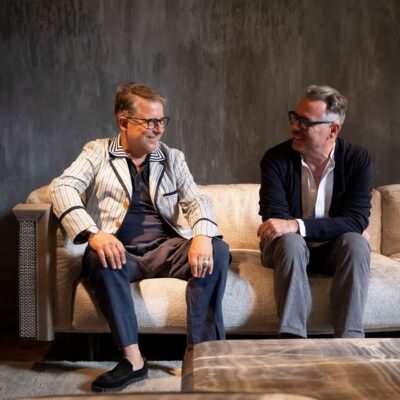Talk: Arte Applicata

Stephan Hamel & Nicola Paccagnella
Arte Applicata was born from the need to combine the professional skills of Stephan Hamel and Nicola Paccagnella in a single office.
Arte Applicata is strongly convinced that to communicate a project it is fundamental to create content and collaborations to give a shape and a development in the world of design, fashion and art. It deals with generating communication and research strategies, interacting with style, marketing and commercial offices to create ad hoc presentations and placements. Over the years have been established collaborations to name only a few as Vibram & Carmina Campus by Ilaria Venturini Fendi (presented at 10 Corso Como Milan, Takashimaya Tokyo, Beijing Design Week Beijing), Vibram & Estudio Campana (presented at Design Miami), Antonio Marras & Istituto Campana (presented at Nonostantemarras Milan during Fuorisalone), Zitanpixel by Stephan Hamel (presented at Nonostantemarras Milan, Galleria Ponzetta Pietrasanta etc), Alpi Wood & Galleria Luisa delle Piane (presented at Nomad Venezia and Saint Moritz), Instituto Campana & Galleria Luisa Delle Piane (presented in gallery Luisa Delle Piane during Milano Design Week and at Nomad Saint Moritz), Lasvit in its complete development.
What were the first sensations you had when approaching Henge’s universe?
The story of HENGE is the successful story of a young family company that has made material research its distinctive trait in the world of design. All over the world the Brand has become famous for the skillful use of the expressiveness of the material, and it is in Milan, in Via della Spiga 7, that this reinterpretation of high Italian craftsmanship is evident. This desire to extend the most sublime beauty, the beauty of nature, to the components of the house is a daring goal that Paolo Tormena reaches in a “unique” way, transforming each element into a “unique piece”; not only the stones but also the furniture and upholstery are emphasised with colours, fabrics, leathers that are the most important elements in his research. Breccia Medicea and Carrara marble become an island kitchen, with a sculptural elegance that expresses all the compressed centuries that can be seen in geological layers and, reflecting on the silver finishes, makes the center of the house vibrate. The softness of the warm atmosphere reminds us of the Venetian light we admired in Tiepolo, Mantegna and many others.
During your long experience in the world of art and culture you have met entrepreneurs, artists, designers and great masters: how important are people for a company?
It is the family that made this journey possible. The family that Paolo has been able to create, an enlightened entrepreneur who listens to all the people involved in his beautiful project, from the artisan and his priceless experience to the person in charge of product development, from the designer to the sales manager, everyone is part of the HENGE family, moving towards a common goal: the well-being of the final user. The sense of family is a very unusual concept in these early twenty years of the XXI century and for this reason it is fascinating, because it defines a new context, a different kind of group. Paolo and his partner, Isabella, form a family and they wanted to extend the sense of union through their creative force, with an interpretation of nature that emerges with explosive force in the HENGE collection, their creation. Certainly creatives such as the designer Ugo Cacciatori and the architect Massimo Castagna have been able to shape the aesthetic needs that Paolo nurtures in his soul. Yabu Pushelberg and Maarten Baas were able to masterfully interpret the company’s poetry.
The HENGE family is constantly evolving because it aspires to grow and expand with many different projects. The design possibilities are limitless and they never get bored: their continuous research innovates the quality of Made in Italy on a daily basis and every day is the beginning of a different vision for innovative domestic solutions.
How important are historical memory and Made in Italy in the current international scenario?
It is in the heart of Veneto, among the dense rows of vines, where the prosecco reigns in a land declared UNESCO World Heritage Site, that the research between art and nature is born, to then develop through continuous journeys in Italy in search of materials and small workshops. And it is makes perfect sense that it was born in this specific area at the end of the Alps overlooking the Adriatic, which sees an archaic and timeless world in the far East with its sparkling metals, as if it had always been there. It is extremely gratifying to live in contexts that provide that exact feeling of elegance and well-being that one seeks to satisfy the inner peace that only beauty can grant. When in 1972 Emilio Ambasz surprised the world with the exhibition ‘The New Domestic Landscape Achievements and Problems of Italian Design’ at the MOMA in New York, it loved that the Italian DNA always knows how to express the utmost excellence through its specific training.
Spoiler: is it true that you are curating a book around the concept of “cooking according to Henge”?
In the research process we are exploring the inclusion of Henge’s kitchen into society. We have discovered that its positioning within the concept of home is of utmost importance and therefore we have foreseen new conceptual possibilities able to reformulate domesticity in a simple, elegant and precise way. This need for domesticity and the Brand’s innovative bond with sustainability makes this panorama particularly exciting. High quality grants the longevity of furnishings, furniture and objects. We are sure that this research will be an immense source of interesting episodes that will legitimise this new concept.
Arte Applicata was born from the need to combine the professional skills of Stephan Hamel and Nicola Paccagnella in a single office.